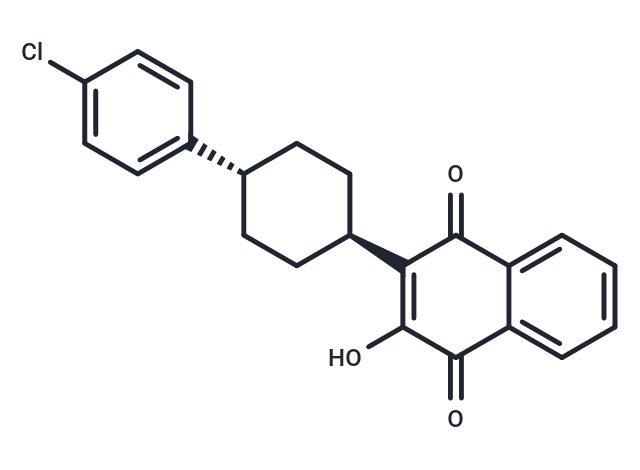Shopping Cart
- Remove All
 Your shopping cart is currently empty
Your shopping cart is currently empty

Atovaquone (Atavaquone) is a hydroxynaphthoquinone that has antimicrobial activity and is being used in antimalarial protocols.

| Pack Size | Price | Availability | Quantity |
|---|---|---|---|
| 10 mg | $43 | In Stock | |
| 25 mg | $81 | In Stock | |
| 50 mg | $147 | In Stock | |
| 100 mg | $218 | In Stock | |
| 200 mg | $323 | In Stock | |
| 500 mg | $543 | In Stock |
| Description | Atovaquone (Atavaquone) is a hydroxynaphthoquinone that has antimicrobial activity and is being used in antimalarial protocols. |
| Targets&IC50 | Cytochrome bc1 (P. falciparum):2.0 nM (IC50), Cytochrome bc1 (human):460 nM (IC50) |
| In vitro | Atovaquone (atavaquone) is a chemical compound that belongs to the class of naphthalenes. Atovaquone is a hydroxy-1,4-naphthoquinone, an analog of ubiquinone, with antipneumocystic activity.[1] Atovaquone is an anti-protozoal mitochondrial electron transport inhibitor; Antimalarial; Antipneumocystic, and has also been used to treat toxoplasmosis. It acts by inhibiting the cytochrome bc(1) complex via interactions with the Rieske iron-sulfur protein and cytochrome b in the ubiquinol oxidation pocket. [2] |
| In vivo | Atovaquone is a unique naphthoquinone with broad-spectrum antiprotozoal activity. It is effective for the treatment and prevention of Pneumocystis carinii pneumonia (PCP), it is effective in combination with proguanil for the treatment and prevention of malaria, and it is effective in combination with azithromycin for the treatment of babesiosis. [3] |
| Alias | Atavaquone |
| Molecular Weight | 366.84 |
| Formula | C22H19ClO3 |
| Cas No. | 95233-18-4 |
| Smiles | OC1=C([C@H]2CC[C@@H](CC2)c2ccc(Cl)cc2)C(=O)c2ccccc2C1=O |
| Relative Density. | 1.349 g/cm3 (Predicted) |
| Storage | Powder: -20°C for 3 years | In solvent: -80°C for 1 year | Shipping with blue ice. | ||||||||||||||||||||
| Solubility Information | DMSO: 3.67 mg/mL (10 mM), Sonication is recommended. | ||||||||||||||||||||
Solution Preparation Table | |||||||||||||||||||||
DMSO
| |||||||||||||||||||||

Copyright © 2015-2024 TargetMol Chemicals Inc. All Rights Reserved.